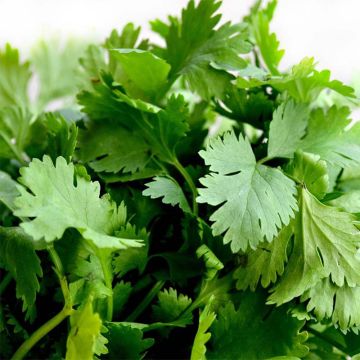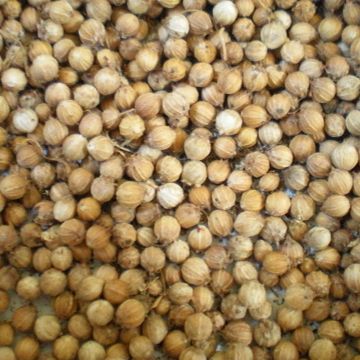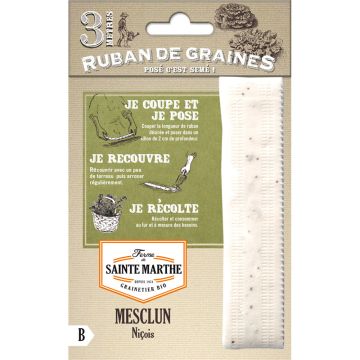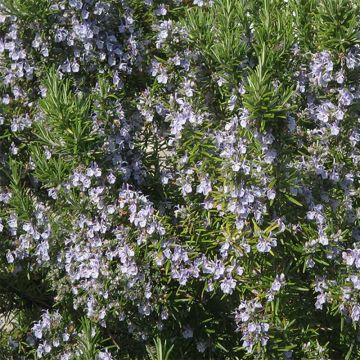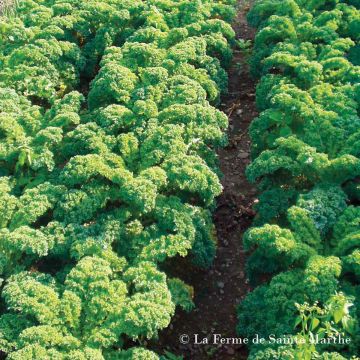

Organic Coriander 'Small Seeds' plugs- Coriandrum sativum
Organic Coriander 'Small Seeds' plugs- Coriandrum sativum
Coriandrum sativum Petites graines
Coriander, Cilantro
The clumps arrived dry and have never recovered, which is a shame as this is rare.
Sodu73, 12/05/2024
This item cannot be shipped to the selected country
Delivery charge from €5.90
More information
Schedule delivery date,
and select date in basket
This plant carries a 6 months recovery warranty
More information
We guarantee the quality of our plants for a full growing cycle, and will replace at our expense any plant that fails to recover under normal climatic and planting conditions.
From €5.90 for pickup delivery and €6.90 for home delivery
Express home delivery from €8.90.
Description
The Small Seeded Coriander, in Latin Coriandrum sativum, is a variety that produces small but highly aromatic seeds. It is an annual plant with foliage similar to parsley. The aroma of coriander is a blend of celery, anise, and orange. Dried leaves and seeds are used in Oriental and Asian cuisine, as well as in Latin American and Mediterranean cooking. Plant it in spring after the last frost, for a harvest throughout the summer as needed. Save some seeds to replant in warm conditions at the beginning of spring.
Our plug plants are certified organic.
The Small Seeded Coriander belongs, like Chervil and Dill, to the Apiaceae family (formerly known as Umbelliferae) and forms a beautiful plant that can reach a height of 50cm (20in). It can be grown in full sun or partial shade, in fairly rich soil.
Although easy to grow, it is one of those highly reactive plants that require a minimum amount of heat to grow, but do not tolerate episodes of drought well, as it quickly goes to seed. To counter this sensitivity and have a continuous supply of this aromatic herb, we recommend staggered plantings, ideally every 3 to 4 weeks.
It is a herb with a fairly strong aroma. The leaves add flavour to marinades, fish, and salads. It is best used raw, as cooking alters its fragrance. The seeds, with their sweet and lemony flavour, are perfect with pickles and can also be ground and used in gingerbread.
Harvest: Coriander (leaves and seeds) can be harvested over a long period, from summer to autumn, provided that planting is staggered.
Storage: Coriander leaves can be stored for a few days in the refrigerator or for several months by drying or freezing. However, for the best aroma, it is preferable to consume them freshly picked. Once fully dry, the seeds can be kept in a paper bag or a jar at room temperature, away from moisture.
Gardener's Tip: To reduce the need for watering, we recommend mulching the soil with thin successive layers of grass clippings mixed with dead leaves, starting from late May. This protective layer helps keep the soil moist and also reduces the need for weeding.
Report an error about the product description
Harvest
Plant habit
Foliage
Other Coriander
Planting and care
Planting coriander in the garden should be done once the risk of frost has passed.
Space the plants 20cm (8in) apart.
Cultivation:
Coriander thrives in full sun (early summer) or partial shade (mid-summer), in fairly rich soil. If additional compost is needed, it should preferably be applied in autumn, in the form of well-rotted compost that is incorporated by raking to a depth of 5cm (2in), after loosening the soil as is done for all vegetable crops.
This plant tends to go to seed quite quickly. You can delay this by cutting the flowering stem.
Coriander is a good companion in the vegetable garden: it stimulates the growth of cucumbers and repels carrot fly. Like all umbellifers, its flowers are highly appreciated by beneficial insects.
Cultivation
Care
Intended location
-
, onOrder confirmed
Reply from on Promesse de fleurs
Organic vegetable gardens
Haven't found what you were looking for?
Hardiness is the lowest winter temperature a plant can endure without suffering serious damage or even dying. However, hardiness is affected by location (a sheltered area, such as a patio), protection (winter cover) and soil type (hardiness is improved by well-drained soil).

Photo Sharing Terms & Conditions
In order to encourage gardeners to interact and share their experiences, Promesse de fleurs offers various media enabling content to be uploaded onto its Site - in particular via the ‘Photo sharing’ module.
The User agrees to refrain from:
- Posting any content that is illegal, prejudicial, insulting, racist, inciteful to hatred, revisionist, contrary to public decency, that infringes on privacy or on the privacy rights of third parties, in particular the publicity rights of persons and goods, intellectual property rights, or the right to privacy.
- Submitting content on behalf of a third party;
- Impersonate the identity of a third party and/or publish any personal information about a third party;
In general, the User undertakes to refrain from any unethical behaviour.
All Content (in particular text, comments, files, images, photos, videos, creative works, etc.), which may be subject to property or intellectual property rights, image or other private rights, shall remain the property of the User, subject to the limited rights granted by the terms of the licence granted by Promesse de fleurs as stated below. Users are at liberty to publish or not to publish such Content on the Site, notably via the ‘Photo Sharing’ facility, and accept that this Content shall be made public and freely accessible, notably on the Internet.
Users further acknowledge, undertake to have ,and guarantee that they hold all necessary rights and permissions to publish such material on the Site, in particular with regard to the legislation in force pertaining to any privacy, property, intellectual property, image, or contractual rights, or rights of any other nature. By publishing such Content on the Site, Users acknowledge accepting full liability as publishers of the Content within the meaning of the law, and grant Promesse de fleurs, free of charge, an inclusive, worldwide licence for the said Content for the entire duration of its publication, including all reproduction, representation, up/downloading, displaying, performing, transmission, and storage rights.
Users also grant permission for their name to be linked to the Content and accept that this link may not always be made available.
By engaging in posting material, Users consent to their Content becoming automatically accessible on the Internet, in particular on other sites and/or blogs and/or web pages of the Promesse de fleurs site, including in particular social pages and the Promesse de fleurs catalogue.
Users may secure the removal of entrusted content free of charge by issuing a simple request via our contact form.
The flowering period indicated on our website applies to countries and regions located in USDA zone 8 (France, the United Kingdom, Ireland, the Netherlands, etc.)
It will vary according to where you live:
- In zones 9 to 10 (Italy, Spain, Greece, etc.), flowering will occur about 2 to 4 weeks earlier.
- In zones 6 to 7 (Germany, Poland, Slovenia, and lower mountainous regions), flowering will be delayed by 2 to 3 weeks.
- In zone 5 (Central Europe, Scandinavia), blooming will be delayed by 3 to 5 weeks.
In temperate climates, pruning of spring-flowering shrubs (forsythia, spireas, etc.) should be done just after flowering.
Pruning of summer-flowering shrubs (Indian Lilac, Perovskia, etc.) can be done in winter or spring.
In cold regions as well as with frost-sensitive plants, avoid pruning too early when severe frosts may still occur.
The planting period indicated on our website applies to countries and regions located in USDA zone 8 (France, United Kingdom, Ireland, Netherlands).
It will vary according to where you live:
- In Mediterranean zones (Marseille, Madrid, Milan, etc.), autumn and winter are the best planting periods.
- In continental zones (Strasbourg, Munich, Vienna, etc.), delay planting by 2 to 3 weeks in spring and bring it forward by 2 to 4 weeks in autumn.
- In mountainous regions (the Alps, Pyrenees, Carpathians, etc.), it is best to plant in late spring (May-June) or late summer (August-September).
The harvesting period indicated on our website applies to countries and regions in USDA zone 8 (France, England, Ireland, the Netherlands).
In colder areas (Scandinavia, Poland, Austria...) fruit and vegetable harvests are likely to be delayed by 3-4 weeks.
In warmer areas (Italy, Spain, Greece, etc.), harvesting will probably take place earlier, depending on weather conditions.
The sowing periods indicated on our website apply to countries and regions within USDA Zone 8 (France, UK, Ireland, Netherlands).
In colder areas (Scandinavia, Poland, Austria...), delay any outdoor sowing by 3-4 weeks, or sow under glass.
In warmer climes (Italy, Spain, Greece, etc.), bring outdoor sowing forward by a few weeks.


































